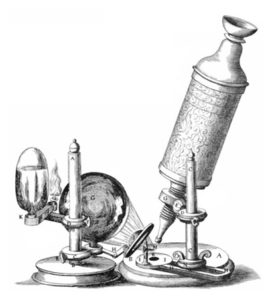
The vast scale of the universe, both cosmic and microscope, is one of the marvels that modern science has revealed. The revelation is the result of the invention of two instruments, the telescope for revealing the cosmic and the microscope for revealing the microscopic. Each of these instruments were invented roughly 500 years ago. Each changed how we thought about our place in the universe.
It is extremely difficult to imagine things on a microscopic scale given the limitations of our human senses. But we can try. Let’s take one example to illustrate the miraculous world of the microscopic. In a single drop of seawater one can find tens of millions of viruses and bacteria. Yet these microorganisms are completely invisible to the naked eye. The invention of the microscope was the instrument that shined a light on the realm of the small.
The Invention of the Microscope
Like many pre-modern inventions, the exact date of the first microscope is disputed, murky, and confused. However it is still possible to shine a light on this inventions beginnings. Credit is most commonly given to Zacharias Janssen and his father Hans Martenz for creating the first microscope as early as 1590, or at least sometime during that decade.
They were, of course, not the first people to have experimented with enlarging objects. Centuries earlier saw lots of people attempting to magnify objects by means of using water to bend light or by using a very simple lens. However it’s probably safe to say that these methods do not meet the qualifications to what most would consider a microscope.
The important point was the people in the ancient world did come to learn that the best way to magnify an object was by viewing it through a lens. The important breakthrough occurred when several lenses were placed in a tube resulting in significant magnification of objects when viewed through a single lens. By using several lens to magnify an object, the compound microscope had just been invented.

Early microscopes came in a variety of forms ranging from single yet sophisticated powerful lens such as the type that Antony van Leeuwenhoek created and used, to simple compound microscopes such as those created and used by Zacharias Janssen, Galileo Galilei, and Robert Hooke. The term microscope was first used in 1625 to describe one of Galilelo’s instruments that he invented in 1609. Although these microscopes provided increased magnification there were persistent problems with the image quality. The major nagging image issue was called chromatic aberration. It is caused by light passing through the lens at different points and color wavelengths, resulting in a color distortions at the edge of the image. This problem persisted early on due to the relative low quality of glass used combined with flaws in design of the microscopes.
It took about 100 years for significant discoveries to be made with the microscope. This is due to early microscopes having low magnifying power and producing blurry images. The first big breakthrough came with the publication of Robert Hooke’s book Micrographia in 1665. The book dazzled the imagination of the people who read it and naturally sparked an enormous amount of new interest in the emerging field of microscopy. Antony van Leeuwenhoek, a contemporary of Robert Hooke, made some of the most powerful microscopes of the early era. Throughout his life van Leeuwenhoek made over 500 microscopes, which were extremely powerful single lenses as opposed to the compound microscopes that Robert Hooke used.
Modern Microscopes
Today microscopes are available in an even greater variety of forms. By the turn of the 20th century the resolution limit of light microscopes had been reached. This limitation was quickly overcame in 1904 when a UV microscope was invented that had double to resolution of a light microscope. Since that time various types of more powerful microscopes have come onto the scene. One of the most powerful is the electron microscope. First invented in the 1930s, electron microscopes employ beams of electrons rather than light (since the wavelength of electrons is up to 100,000 times shorter than that of light), allowing for significantly greater magnification.
Today’s most powerful electron microscopes allow researchers to see resolutions so clearly that they can view images of individual atoms. Viruses can be viewed at a scale of less than four angstroms, or four ten-billionth of a meter. Resolution of this magnitude provides a powerful tool in advancing the field of microbiology.
Continue reading more about the exciting history of science!